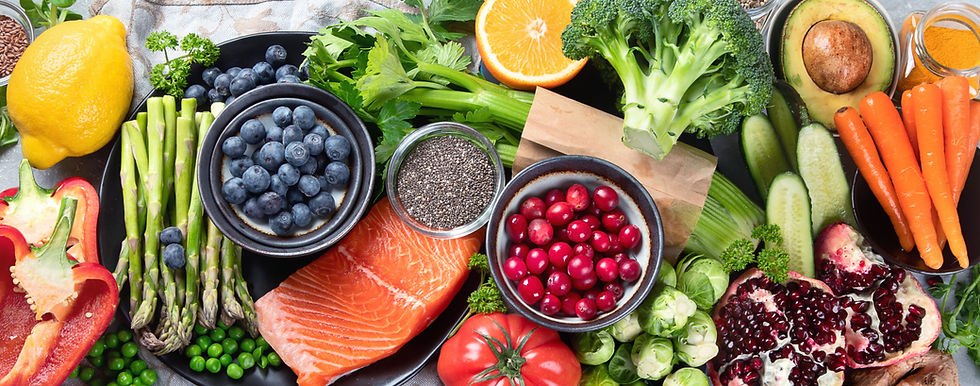Insulin Resistance – The Silent Epidemic
- Helen Gowers
- Sep 16
- 5 min read
Updated: Sep 19

Introduction
Insulin resistance is at the root cause of type 2 diabetes, heart disease, colorectal, liver, pancreas, breast, endometrial and prostate cancers, polycystic ovary syndrome (PCOS), sleep apnoea, and dementia, and yet it is rarely mentioned when discussing health. It occurs when cells in the liver, muscle and adipose tissue stop responding to the hormone insulin properly. All carbohydrates are digested into glucose and insulin pushes glucose from the blood into cells for energy or storage to tightly control blood glucose levels. When cells become insulin resistant, the pancreas responds by producing more insulin, increasing insulin resistance and starting a cycle of hunger and weight gain which is difficult to break. Here is a quick guide to insulin resistance and how to minimise your risk of developing chronic diseases as you age.
Signs of Insulin Resistance
Insulin resistance is a natural physiological state during adolescence and pregnancy to promote growth. However, overconsumption of highly palatable snacks and drinks is causing a surge in insulin resistance in the population at all ages. The first signs of insulin resistance might be feeling hungry all the time, lack of energy or poor concentration, especially after eating. Weight gain particularly around the middle, high blood pressure, fatty liver, skin tags and dark skin patches called acanthosis nigricans are also common symptoms.
Causes of Insulin Resistance
Where you store your fat is more important than how much you store. Everyone has a personal fat threshold for storing fat all over the body as adipose tissue and once these stores are full, excess calories overflow into the liver and surrounding abdominal tissues causing insulin resistance and associated chronic diseases. South Asian or Black ethnicities tend to have a lower fat threshold than White, meaning they develop insulin resistance at a comparatively lower BMI, but it is very individual. This is why some people present with insulin resistance and related diseases whilst still a normal weight. Hyperpalatable ultra-processed foods rich in sugar and refined starches are designed and marketed to drive over consumption causing raised insulin levels. This coupled with our sedentary and high pressure lifestyles leads to weight gain and, once our personal fat threshold becomes exceeded, insulin resistance results.
How to measure Insulin Resistance
There are tests for insulin resistance, but they are expensive and rarely done in the NHS. However, there are lots of markers which are easy to check. The quickest is a simple waist circumference measurement. Your waist should be less than half your height which you can test using a piece of string! Raised blood pressure is also a good indicator of insulin resistance, so are two blood lipid measurements triglycerides which are a type of fat in the blood and High Density Lipoprotein (HDL) often known as good cholesterol. Having 3 or more markers is called metabolic syndrome but having any of these markers shows that it is likely you have insulin resistance.
Markers of Insulin Resistance | Indication of Increased risk |
Increased Waist Circumference | Men >94cm Women >80cm Asian Men >90cm |
Raised Blood Pressure | >130/80mmHg or on medication to lower |
Raised Triglycerides | >1.7mmol/l or on medication to lower |
Raised High Density Lipoprotein HDL | Men <1.0mmol/l Women <1.2mmol/l |
Raised Fasting Blood Glucose | >5.6mmol/l |
If insulin resistance is not tackled, it is a lottery as to which metabolic diseases you may develop. You may be predisposed to one disease over another depending on your genes whether heart disease, diabetes, cancer, or dementia. As the pancreas tires and becomes unable to produce enough insulin to overcome the resistance, blood glucose levels will start to rise. At this point prediabetes or type 2 diabetes is diagnosed often decades after insulin resistance first started.
How to improve Insulin Resistance
The good news is that in most cases insulin resistance can be reversed completely, or at least improved significantly, through diet and lifestyle changes. Losing your excess fat around the middle and enabling your cells to become more sensitive to insulin is key. This is best done through weight loss by improving what and when you eat but increasing exercise, stopping smoking, reducing stress levels and prioritising sleep are also very helpful.
It is best to think of this as adopting a healthier lifestyle rather than 'going on a diet' as its important to make changes that are sustainable. Here are 5 important pointers:
1) Reduce ultra-processed food (UPF) and eat whole food whenever possible.
Avoid snacks, drinks and ready prepared foods high in sugar, salt, processed fats and starches which are designed to make you overeat them. Buying food as raw ingredients and cooking them from scratch is the best approach and with a bit of planning can be more economical too.
2) Prioritise protein and fibre
Whether you eat meat, fish, eggs, dairy, pulses or alternative protein sources aim for 1.5g of quality protein per kg ideal body weight. For example, if your ideal weigh is 80kg, you should be eating around 160g of protein each day. Fruit and vegetables, whole grains, nuts and seeds contain fibre for a healthy digestive tract. Remember that tropical fruits and all fruit juices contain a lot of sugar.
3) Try to consume all your meals within a shorter window.
Restricting the time window when you eat is called Time Restricted Feeding and evidence shows that the body likes to have time to process meals and utilise its energy reserves rather than constant snacking. For example, if you eat breakfast at 9am and finish your dinner by 7pm this is a 10-hour window for eating leaving 14 hours of fasting until your next meal. Fasting for longer can be particularly helpful when trying to lose weight as it allows time for insulin levels to normalise and fat reserves to be used as fuel.
4) Incorporate aerobic and weight bearing movement into each day.
Aerobic exercise such as walking, cycling, swimming, dancing and running help reduce insulin resistance by raising metabolic rate and using up excess glucose from the blood. However, strength training is also very important to build muscle and reduce muscle wasting due to aging or weight loss. Rather than think of exercise as a bolt on, try to incorporate it into your routine such as taking the stairs at work, parking further from your destination or doing some squats whilst brushing your teeth!
5) Nurture yourself in nature
Despite our incredible achievements as a species, human bodies are designed for prehistoric life. Ensuring we value sleep, community, relationships, managing stress, relaxation, hobbies and interests and connecting with nature will keep our circadian rhythms, hormones, basic drives and instincts running smoothly and reduce our risk of developing insulin resistance and associated chronic diseases.

References
1) Fertig BJ, Chopra D, Tuszynski JA (2022) The Four Stages of Insulin Resistance Induced Chronic Diseases of Aging. J Altern Complement Integr Med 8: 232.
2) Taylor R, Barnes A, Hollingsworth K et al (2023) Aetiology of Type 2 diabetes in people with a normal body mass index: testing the personal fat threshold hypothesis. Clin Sci (Lond) 137(16) 1333-1346
3) Lonnie M, Hooker E, Brunstrom JM, et al. Protein for Life: Review of Optimal Protein Intake, Sustainable Dietary Sources and the Effect on Appetite in Ageing Adults. Nutrients. 2018 Mar 16;10(3):360.
4) Ding C, Chan, Z, Magkos F. Lean, but not health: the metabolically obese normal-weight phenotype. Current opinion in Clinical Nutrition and Metabolic Care 19(6):0408-417 2016
5) Antoni R, Johnston K, Collins A, Robertson MD. Effects of intermittent fasting on glucose and lipid metabolism. Proceedings of the Nutrition Society. 2017;76(3):361-368
6) Szablewski L. Insulin Resistance: The Increased Risk of Cancers. Curr Oncol. 2024, 31 998-1027


Comments